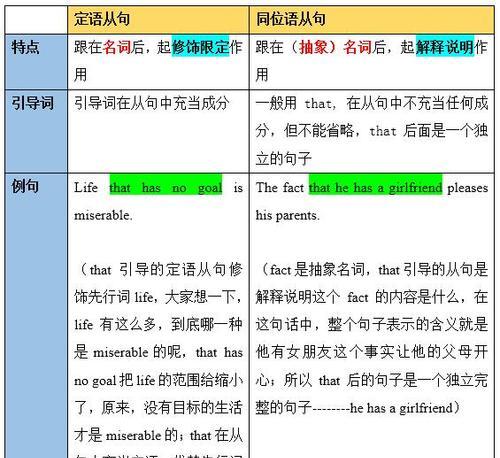同位语从句是英语从句的一种,通常由“that”等引导词引导,用于解释或说明前面的名词或名词短语。其构成包括引导词、主语和谓语三个部分。例如,“The fact that he passed the exam made his parents proud”,其中“that he passed the exam”是同位语从句,“that”是引导词,“he passed the exam”是主语,“made his parents proud”是谓语。掌握同位语从句的构成和使用方法,可以使英语写作更加丰富和生动。

同位语从句的构成可以分为以下三个部分:
1. 引导词
同位语从句通常由“that”引导,但也可以使用其他引导词,如“who”,“which”或“whether”。引导词位于同位语从句的开头,用于引导从句。
例如:
- The fact that he passed the exam made his parents proud.
- The idea that we should take a vacation in Hawaii sounds great.
- The question of whether we should invest in stocks or bonds is still being discussed.
2. 主语
同位语从句的主语通常是引导词所指的名词或名词短语。主语位于引导词之后,用于说明或解释名词。
例如:
- The fact that he passed the exam made his parents proud.(“that he passed the exam”是同位语从句,“that”引导从句,“he passed the exam”是同位语从句的主语)
- The idea that we should take a vacation in Hawaii sounds great.(“that we should take a vacation in Hawaii”是同位语从句,“that”引导从句,“we should take a vacation in Hawaii”是同位语从句的主语)
- The question of whether we should invest in stocks or bonds is still being discussed.(“of whether we should invest in stocks or bonds”是同位语从句,“whether”引导从句,“we should invest in stocks or bonds”是同位语从句的主语)
3. 谓语
同位语从句的谓语通常是一个动词或动词短语,用于说明或解释名词。谓语位于主语之后,用于说明或解释名词。
例如:
- The fact that he passed the exam made his parents proud.(“made his parents proud”是同位语从句的谓语)
- The idea that we should take a vacation in Hawaii sounds great.(“sounds great”是同位语从句的谓语)
- The question of whether we should invest in stocks or bonds is still being discussed.(“is still being discussed”是同位语从句的谓语)
